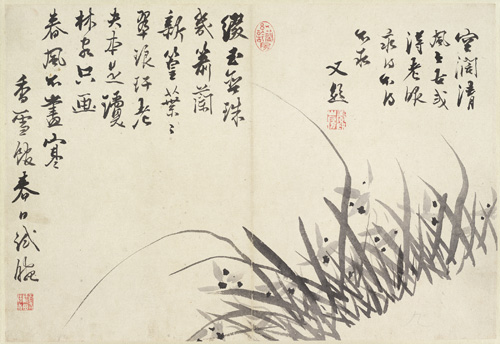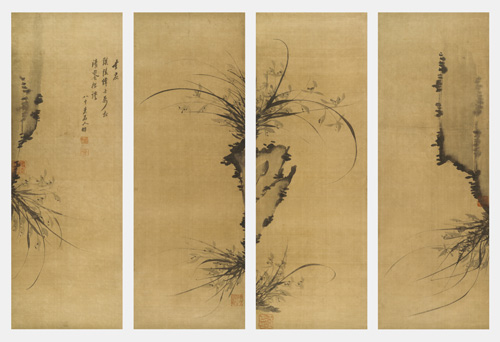Cultivating Virtue
Post #841 • July 31, 2006, 6:04 PM • 5 Comments
This week I'll be going through the Cultivating Virtue show at the Sackler. Anne Rose Kitagawa, one of the curators of the exhibition, treated me to an information-packed walkthrough, and I feel inclined to give it the equivalent treatment here.
A notable feature of this exhibition is its inclusion of high, literary Korean art. Korea has been poorly represented in a field dominated by specialists in Japan and China. Connoiseurship of Korean objects has concentrated disproportionately on folk art and peasant ware, an approach exemplified, although not wrongfully by any means, by Soetsu Yanagi. (You can see this at work at the MFA. You go from the Japanese ceramics to the Korean, and suddenly things looking casually charming and funky.) That left an opening for the Sackler to acquire objects created by the literati class, and it now has the foremost collection of such objects in the country.
As one would expect, the themes and the writing are Chinese. These were learned Confucians, and it would have been unseemly for them to write in Hangul. They also adopted the tradition of the Four Gentlemen, which placed bamboo, orchids, mums, and plum blossoms at the center of the botannical pantheon. These were not only beautiful specimens of nature, but embodiments of virtues. Bamboo, for instance, is sturdy but flexible. (An old Japanese proverb says that the bamboo that bends is stronger than the oak that resists. Dr. Yang told his seminar students last week that his master used to remind him that the taller a bamboo grows, the more it bows down.) Orchids, growing on cliffsides, represent uncultivated, natural grace, and via an association with Spring, a balance of Yin and Yang.

Cho Hui-ryong (1797-1859), Orchids, Korean; Choson dynasty, first half 19th century. Folding album leaf mounted as a hanging scroll; ink on paper; with inscriptions and seals of the artist, 28.2 x 41.2 cm. Courtesy of the Arthur M. Sackler Museum, Harvard University Art Museums. Purchase in honor of James Cuno through the generosity of Mariot Fraser Solomon and through the Alpheus Hyatt Purchasing Fund. Photo: Photographic Services © President and Fellows of Harvard College.
If the above work looks especially Korean in some way, my eye can't detect it. But as an extension of the Chinese tradition it wants for nothing. It's a perfect expression of unaffected ease. The Koreans didn't have a monk-painter tradition like the one that took root in Japan, but this has a similar wild tone, and if charm were fire, it would burn down the wall.
Update: This image isn't on the checklist I received from the Sackler but I'm almost positive that it's Korean. I'll work on the attribution. Update 2: Got it.

Yi Ha-Ung, Orchids and Rocks, Korean; Choson dynasty, datable to 1896-98. Set of four hanging scrolls; ink on silk; 87.5 x 30.8 cm. Courtesy of the Arthur M. Sackler Museum, Harvard University Art Museums. Purchase in honor of John M. Rosenfield through the generosity of Mariot Fraser Solomon, 2005.99. Photo: Photographic Services © President and Fellows of Harvard College.
2.
August 1, 2006, 8:14 AM
Jack, I'll go find out.
3.
August 1, 2006, 11:15 AM
That's a wonderful sample. I'm struck by how similar the arrangement is to a drawing I drew Saturday past. Sitting at the lake, I was also mesmerized by crisscrossing grasses sloping down across the lower corner.
I find my eye keeps being drawn away from the calligraphy and flora down to the lower right triangle of white space. I think the corner could be subdued by providing some faint tonal change, maybe a very light wash.
4.
August 2, 2006, 4:27 PM
About the hanging scrolls:
The spacing between them seems considered... was this set by the artist, or by the curator?
The image makes it look a bit like the four inividual images have been Chine Colle'd onto a backing paper support, although this is surely not the case...
5.
August 2, 2006, 6:21 PM
I'd have to see it again, Mark. They're definitely remounted in the classic manner, but whether the panels are attached I didn't notice.
1.
Jack
July 31, 2006, 8:31 PM
Franklin, is the text a poem, prose or what?